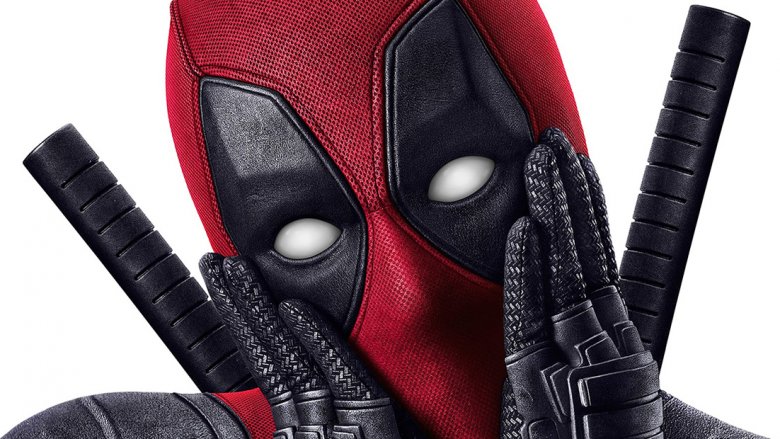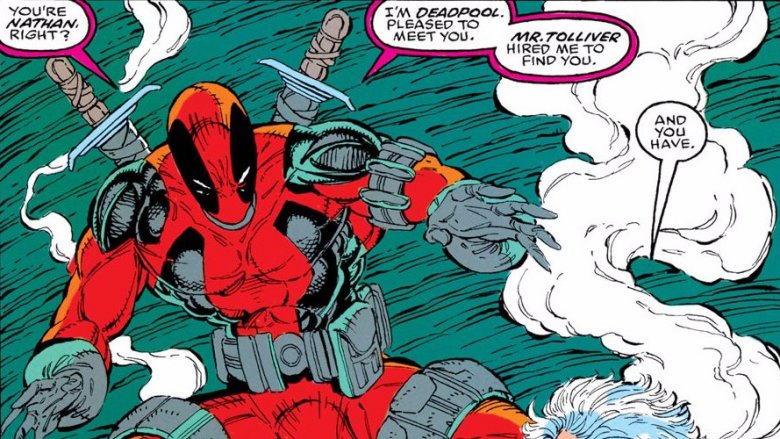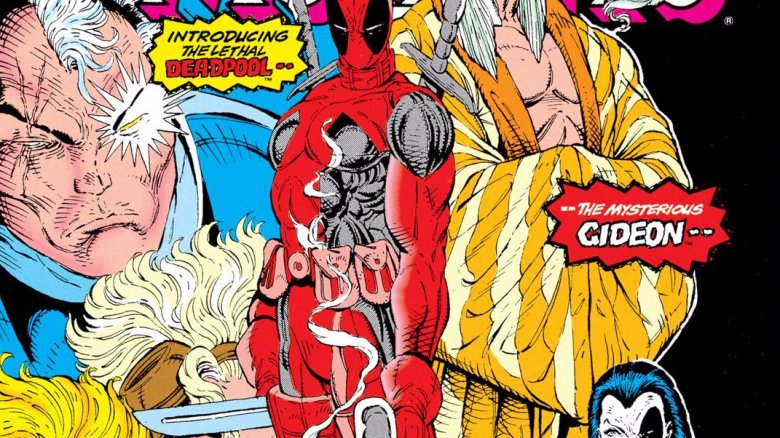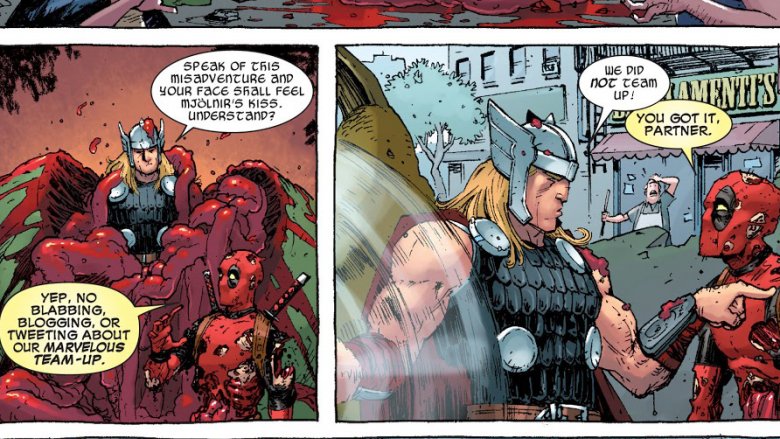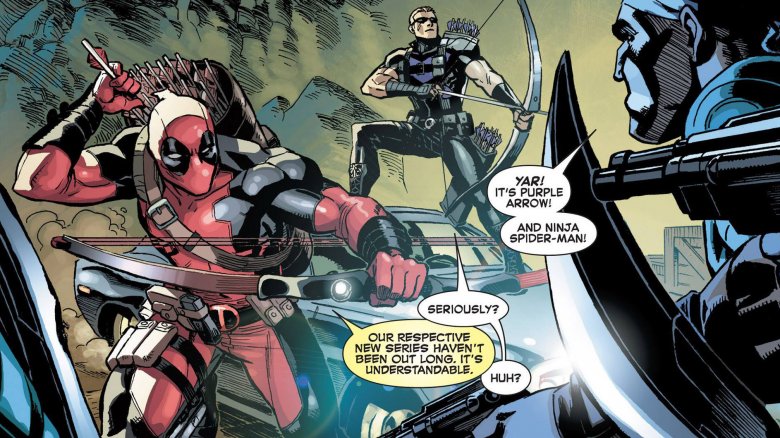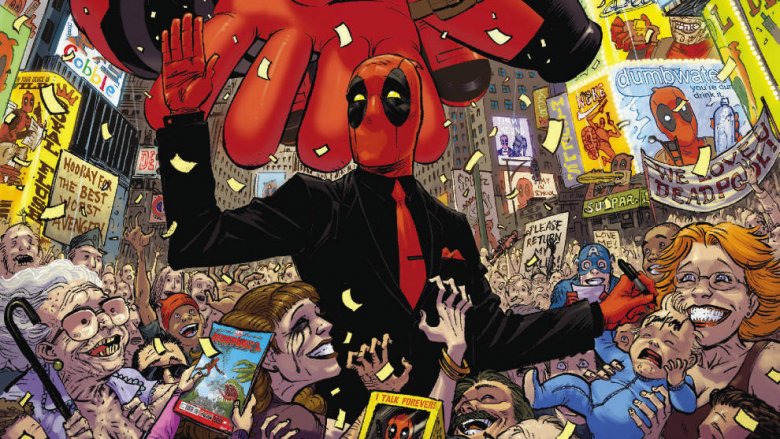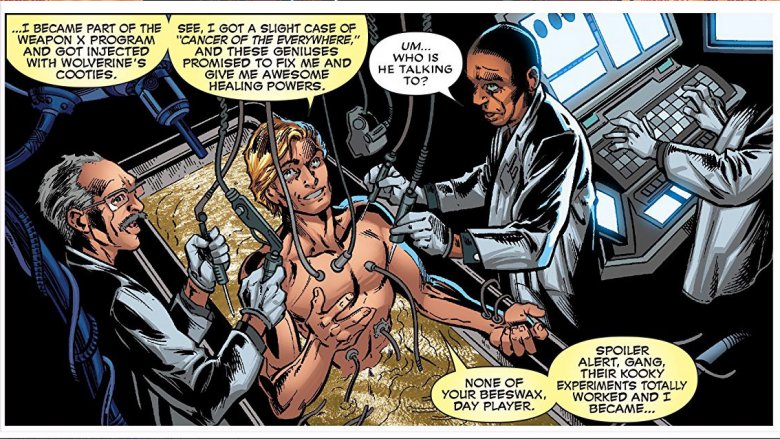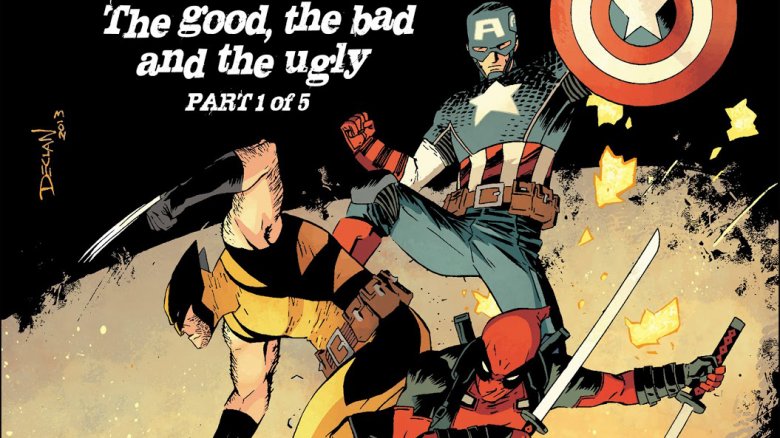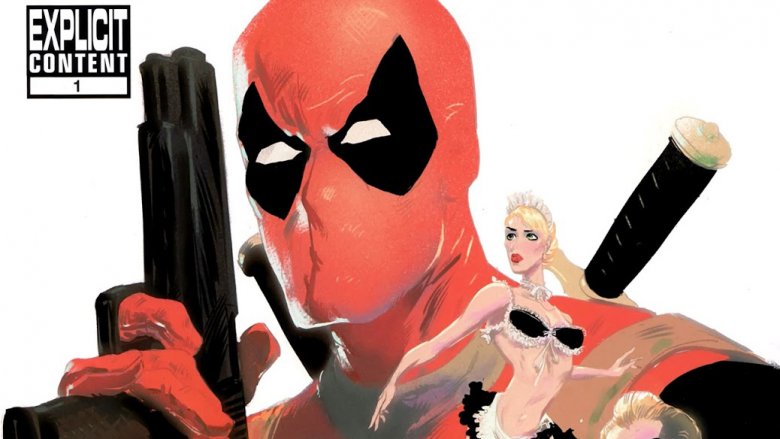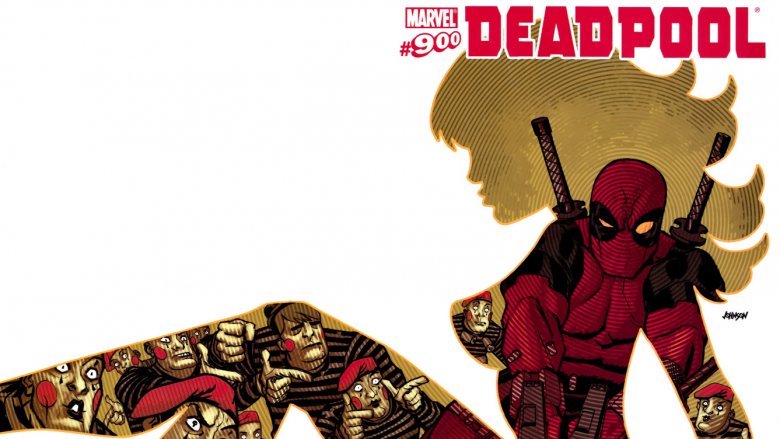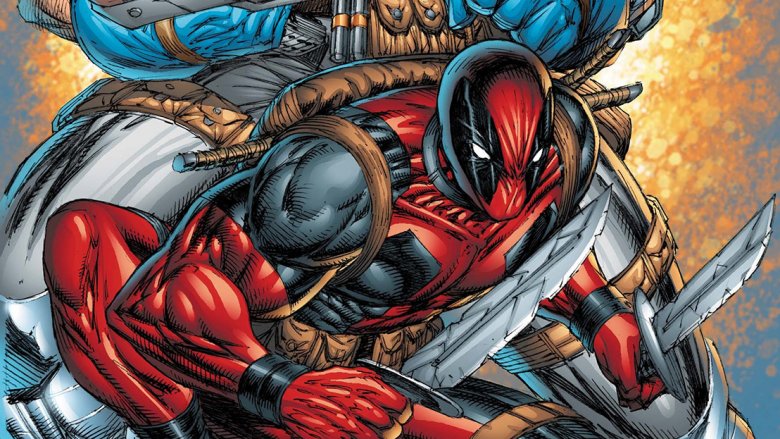How Deadpool Changed Comics And No One Noticed
With an unstoppable healing factor, a massive arsenal of guns and swords, and an endless string of quips, Deadpool has battled his way to the top of the superhero game. Over the past few years, he's become a household name and one of the most beloved superheroes in film, and his comic book popularity shows no sign of slowing down. Look a little closer, though, and you'll see that Wade Wilson has done more than just bring down bad guys as a part-time superhero and full-time mercenary. He's also changed the way comics work, sometimes in ways so small that you might not notice how influential he's been.
From proving that humor can work in wildly popular superhero comics to showing that constant redesigns aren't as good as a single iconic look, all the way to an origin story that connects Captain America to Wolverine, here are under-the-radar ways that Deadpool changed comics.
The clothes make the merc
One of the most notable things about Deadpool is that with the exception of a few minor tweaks that can usually be chalked up to the personal preference of the artist, he's wearing the same costume today that he was when he made his first appearance in 1991. There are a few alternate versions, including a palette-swapped black-and-grey version that he wore as part of Uncanny X-Force, but his core look is the same red-and-black gear he was rocking on day one.
That might not seem all that notable, but consider that in that same amount of time, some of the most iconic superheroes of all time have gone through multiple redesigns. Batman has had at least six major costume changes in that time — not including the times when Bruce Wayne wasn't the man under the cowl — and Wonder Woman's been through four. Superman, whose costume is arguably the single most definitive look a superhero has ever had, has been through four, too. Wade Wilson, meanwhile, has been wearing the same spandex suit since New Mutants #98. Well, hopefully not the exact same one — 25-plus years of mercenary work is bound to make any set of clothes pretty ripe.
There have certainly been plenty of costume redesigns that are great, and even necessary, but Deadpool's signature look proves that if it ain't broke, it doesn't need fixing, even when it's being translated into a live-action movie. Unless it's X-Men Origins: Wolverine, that is, but we try not to talk about X-Men Origins: Wolverine.
The dream of the '90s is alive in Deadpool
Every era of comics is marked by certain aesthetics. If you're looking at square jaws, flat colors, and heroes saying things like "Great guns!" while fighting giant-headed aliens, then chances are pretty good that you're reading something from the Silver Age of the '50s and '60s. If they're grimacing in the agony of making hard choices and talking about how the real crime is the injustice of society, then you've probably got something from the '70s. If Superman's crying, you're reading a comic from the mid-2000s, and should find something else to do immediately.
The one big aesthetic that everyone recognizes, though, is the '90s: gritted teeth, plenty of cross-hatching, guns and swords, and belts and bandoliers loaded up with pouches that never seem to contain anything. It's such a definitive look that as soon as comics moved past it onto the "cinematic" leather-and-seams look of the late '90s, it became a source of plenty of jokes, and a shorthand for the excesses of an era.
Deadpool, however, never really moved past that look. If anything, he came to embody them, with the swords, guns, and attitude that he was created with. Judging by the success the character has enjoyed with new fans and those nostalgic for the heyday of the Extreme Age, he clearly didn't need to move beyond. It might not work for everyone, but Deadpool showed there was plenty of value to that '90s style.
Funny = money
For a certain kind of reader, superheroes are serious business. These are the fans who cringe at the goofier, more lighthearted Batman stories of the '60s, or who think that the only good stories are the ones with mature themes that show the dark and realistic side of flying aliens and magic rings from space. Sometime in the '80s, that became what the audience preferred and what the publishers provided, with most superheroes having only the slightest hints of comedy.
Until Deadpool proved that a comic could be hilarious, action packed, and perhaps most importantly, wildly popular. The character had always had a dark sense of humor, an attitude that creator Rob Liefeld lifted from Spider-Man, but when he moved into his ongoing series, Joe Kelly and Ed McGuinness really put the mouth into the merc. His constant quips came to define the character, and the wacky situations that he'd get into as a killer for hire would set the stage for plenty of comedy.
In a time when even the late '80s Justice League comic was looked back on as nothing more than a wacky superhero sitcom despite the fact that it delivered plenty of action to go along with its laughs, Deadpool proved comedy could work. When he rose to prominence as one of Marvel's most popular characters, the jokes came with him, and his self-titled movie is probably the funniest superhero film of all time. The folks at DC definitely noticed: Harley Quinn's rise as one of their most popular characters came on a road paved with comedy too.
Smashing the fourth wall
One of the most difficult things to pull off in superhero comics is breaking the fourth wall. No matter how serious a superhero story is, it's still part of a genre that, as legendary writer Mark Waid said, is built on the idea that no one can tell who Superman is when he's wearing a pair of glasses. Pointing out all the weird logic that readers have come to accept as part of the genre runs the risk of making the entire story collapse, taking the reader out of it. Read a Deadpool comic, though, and you'll find a character who doesn't just break the fourth wall — he smashes through it on a wrecking ball and swings back around to take another shot.
Part of what makes it work is that it's something that's usually portrayed as unique to him. That in turn makes it easy for other characters to dismiss as nonsense, the ramblings of a madman who's not quite all there. At the same time, he's paved the way for other characters, including the semi-spinoff Gwenpool, whose origin story is that she's a comic book reader from our world that was brought into the Marvel Universe with all her knowledge of secret identities and storytelling conventions that she could use in her own career as a mercenary. It worked for her, too, even if it's never going to be the kind of thing you want Captain America and Spider-Man doing.
At the same time, it works for Deadpool in part because, while he occasionally acknowledges that he's a comic book character, he's also fully aware that this is the world he lives in, and that it's very real to him. Knowing there's someone out there writing your story and that you're the main character also means that you know you're probably going to go through some pretty terrible stuff.
Upward mobility
If you're an aspiring creator looking to make it big in comics, we've got some bad news: you're probably not going to make the next Superman. That's not a knock on you, it's just that there probably won't be another Superman, or Batman, or Wonder Woman, or Spider-Man, at least not in the way that those characters were created and came to define their roles in the universe. The good news, though, is that there's almost certainly going to be another Walking Dead or Hellboy... and we know that because of Deadpool.
Even though he's a relatively new character, and even though it took a long time for him to catch back up to (and surpass) that initial burst of popularity in the early '90s, it's hard to imagine the current Marvel Universe without him. Recent years have seen him going mainstream, becoming a crossover hit with two major movies, and showing up on t-shirts that you can buy in Target.
It's tempting to say that's a level of fame that used to be reserved for the biggest characters in comics, but that's not quite it. The fact is that Deadpool became one of those characters, and showed that there are always going to be opportunities for unlikely heroes to rise to prominence.
The Wolverine connections
When Deadpool was created, the single most popular character at Marvel was unquestionably Wolverine, the adamantium-laced X-Man who redefined the badass superhero in the '80s and has been riding that wave of popularity ever since. With that in mind, it makes a lot of sense to tie your brand new character into his history. It had been done before with his arch-nemesis, Sabretooth, and the solo Wolverine comics would wind up diving pretty deep into the Weapon X program, but Deadpool brought in something new right from the start.
On Liefeld's first sketch of Deadpool, he's identified as "Weapon 9," a prototype version who wasn't quite as refined as Weapon X — or as you might pronounce it if you're not a fan of Roman numerals, "Weapon 10." It makes sense for the character, in that his healing factor leaves him scarred and is constantly at war with the cancer that drove him to volunteer for the program in the first place, but it also opens the door for other characters to be tied to that history in the same way.
Ten years after that original sketch, writer Grant Morrison detailed the history of the renamed "Weapon Plus" program, with other creators coming along to add more once the floodgates were open. Along with Deadpool and Wolverine, Weapons IX and X respectively, it was revealed that other government-created super-soldiers were part of the program, too. Nuke, the psychopathic, drug-powered soldier who showed up in Frank Miller's early '80s run on Daredevil (and on Netflix's Jessica Jones) was Weapon VII, and Captain America was revealed to be Weapon I (with his own prototype, Isaiah Bradley, shown as Weapon 0).
Getting into the big leagues
It's pretty surprising to look back on now, but Deadpool's first shot at headlining his own ongoing series didn't really go that well. The character had an initial burst of popularity after his first few appearances, with a role in the original X-Force that saw him getting a few featured miniseries that helped to flesh out his past. That led to his own title, but while it ran for 69 issues plus a handful of annuals and specials, it never really rose beyond the level of a cult favorite. Once the initial creative team left, the comic had a lot of trouble finding a distinct voice until writer Gail Simone arrived... right before it was canceled and rebooted, canceled and rebooted again, and then combined with another comic that wasn't selling as well as it once had.
But that's the thing about cult favorites: give them enough time, and they might just eventually become favorites. That's exactly what happened a few years later when Marvel revived Deadpool under writer Daniel Way, whose approach to comedy and action appealed to the same audience that had been digging through back issues to read the Deadpool comics they'd missed out on the first time around. When that book hit, it launched Deadpool into the stratosphere, to the point where there was a time when five or six Deadpool books were coming out every month.
That's the kind of success that's only really rivaled by characters like Superman, Batman, and Spider-Man, who've been holding down multiple monthly titles for decades. To go from a book that was almost canceled to that kind of success proved that with the right stories, the right creators, and the right push from the publisher, other characters could rise to that point, too.
Rated R… and also PG
When you have a popular character, especially one at the level of Deadpool, there's always going to be a temptation to do different versions to suit different markets. Batman, for instance, has often had different versions that existed in pop culture, from the campy '60s TV show, to the dark but all-ages Batman: The Animated Series, to Tim Burton's gothic films, and beyond. Even when that's the case, though, there's a hard line drawn between different versions, so that consumers aren't confused about which version they're getting.
Deadpool, on the other hand, has been approached pretty differently. There are multiple comics telling different kinds of stories, but unlike the divisions between the "real" comic book Batman and his kid-friendly counterparts or film versions, there was a sense that Deadpool comics were always meant to be about the same guy, just in various adventures. The digitally published comedy/action story about Deadpool fighting Dracula had the same character that was showing up in Uncanny X-Force to debate whether it was right to kill a young reincarnation of Apocalypse, who was the same character having ultra-violent, cuss-filled adventures in the Mature Readers-only Deadpool MAX.
To paraphrase Walt Whitman, Deadpool is large. He contains multitudes.
Numbers? What numbers?
One of the most common complaints about mainstream superhero comics is that for books that always have numbers on the covers, they can be incredibly difficult for new readers to put in the right order. With reboots, miniseries, Legacy Numbers, and a constant stream of #1 issues that are designed to boost sales, it's easy to see why. That's what makes it so surprising that Deadpool is as popular as he is, since the creators behind those books decided to throw the very concept of numbering out the window.
Part of it is the usual amount of reboots (there have been three different comics just called Deadpool since 2008, plus dozens of spinoffs and secondary titles), but another part is an intentional parody of those same constant reboots.
The 2008 Deadpool comic ran for 65 issues, but the last one is #63, because #900 came out between #16 and #17. There's also a #1000, but it didn't come out 100 issues after #900, it came out 10 months later. Oh, and Deadpool #900 was also the first issue of Deadpool Team-Up, which then officially started at #899 (while Deadpool continued) and counted backwards until it ended at #883. If you're confused right now, that's okay. You honestly should be.
He made Rob Liefeld a superstar... twice
Rob Liefeld has been a comics superstar since he burst onto the scene in the late '80s. He helped to define the look of comics in the '90s, was one of the seven artists who left Marvel to found Image, and was responsible for some of the highest-selling comics of all time. He's also polarizing, with diehard fans as well as readers who claim that he's responsible for everything bad in comics. One thing that you can't argue, though, is that along with writer Fabian Nicieza, he's the one ultimately responsible for Deadpool.
Deadpool's certainly not Liefeld's only creation. During his time at Marvel, he was responsible for Cable, Shatterstar, Domino, and most of the other members of X-Force, and after leaving, he created Youngblood and Supreme, which would play host to one of the greatest superhero stories of all time when Alan Moore used him as a stand-in for Superman. That said, Deadpool marked the beginning of Liefeld's peak at Marvel. Only a few months after he first appeared in New Mutants #98, X-Force #1 would launch, selling 5,000,000 copies.
While Liefeld never left comics, Deadpool's popularity would also bring him back to Marvel. In 2010, he'd reunite with his most famous creation, becoming the regular artist of Deadpool Corps, with multiple projects following over the course of the next decade.
